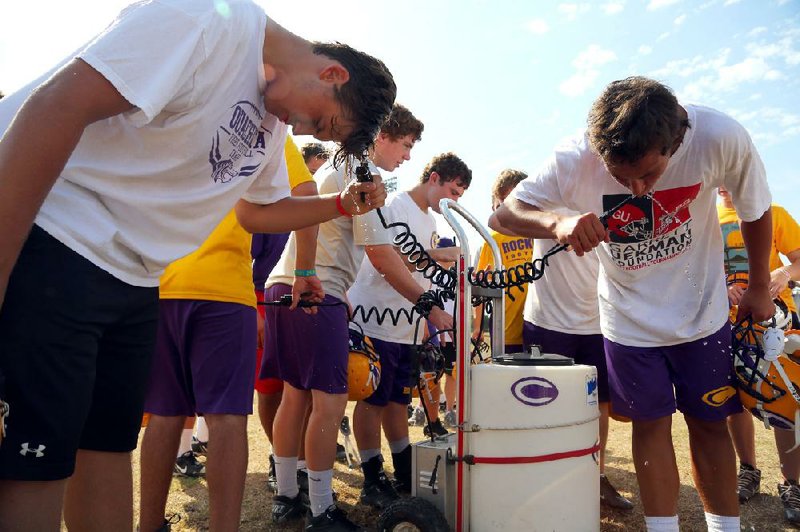LITTLE ROCK — The first day of Sylvan Hills football practice had been over roughly three hours, but there was still a reminder of how dangerous Arkansas heat can be during the summer.
Bears Coach Jim Withrow said he was in a meeting with his assistants early Monday afternoon when a former student at the school came to the field house requesting water.
Withrow said the student, who attends the University of Arkansas, subsequently fainted from apparent heat exhaustion, moments after jogging on the track at Bill Blackwood Field in Sherwood in temperatures approaching 110 degrees.
“He just walks up and passes out,” Withrow said,adding the student was out for about 30 seconds. “We did everything we were supposed to do on that crisis plan.”
Withrow said coaches used ice packs, water and the shower to treat the student.
Paramedics gave the student intravenous fluids and he was “OK” early Monday afternoon, Withrow said.
“Hope I never use it again,” Withrow said of crisis training.
Coaches must attend classes on dealing with heat illness and concussions every three years, as mandated by legislation approved in April 2011, which is part of sweeping reform regarding player safety in Arkansas high schools.
The Arkansas Activities Association’s 19-member board of directors further strengthened sports medicine requirements in June, adopting, among other things, a five-day heat-acclimation window for preseason football practice.
The new guidelines took effect Monday, the first day of fall drills for most high schools around the state.
Withrow said he applauds the changes, particularly when athletes have to practice in extreme temperatures.
“It’s something I don’t think you can talk enough about,” Withrow said.
Sylvan Hills, like many schools around the state, avoided the most intense heat Monday and practiced from 8 a.m.-10 a.m.
Conversely, Helena-West Helena Central was scheduled to practice at 5:30 p.m. Monday.
The temperature in Little Rock was 110 degrees at 2:04 p.m. Monday and 111 - the third-highest reading in city history - at 3:50 p.m.
It had already climbed to 100 degrees at 10:17 a.m., shortly after Sylvan Hills had completed practice.
“I felt it at 5:30 this morning,” Withrow said of the heat. “When I walked out the door, I couldn’t believe it.”
Withrow described Monday’s practice as light, but said several players still threw up.
Withrow said water is always available for his players.
B.J. Maack, owner of Arkansas Sports Performance Center in Little Rock and past president of the Arkansas Athletic Trainers’ Association, said education is just as important in keeping players healthy.
Leading up to the start of fall practice, for example, North Little Rock, Jonesboro and Stuttgart urged their players through Twitter messages to hydrate properly before practice and monitor urine color.
“We can guideline and rule and legislate everything to death,” Maack said. “But until everybody realizes what they’ve got to do as an athlete, as a coach, as a parent - the more people that know what’s up - that’s going to be a whole lot better than any rules or stuff like that.”
Maack said it is his understanding that Arkansas Children’s Hospital in Little Rock didn’t treat any players last year for heat illness.
Tyler Davenport, a junior lineman from Lamar, spent about two months in Arkansas Children’s Hospital before dying from heat-related complications in October 2010.
Davenport’s death heightened awareness in heat-related illness and promoted state government, coaches, athletic trainers and the AAA to collaborate on aggressive sports medicine reform.
The AAA administers rules and regulations agreed upon by member schools.
“All that chatter is probably our best tool,” Maack said. “I’m thrilled about the attention it’s getting because the most important thing I’ve learned through this process is every heat illness is 100 percent preventable.”
New AAA heat/concussion guidelines for football
The only contact equipment that can be worn during practice on Day 1 and 2 of fall practice is helmets. There is to be no contact and only one practice is allowed (no longer than three hours). A one-hour walk through is permitted following practice, but it must be separated by a one-hour rest and recovery period.
Helmets and shoulder pads are the only contact equipment that can be worn during practice on Days 3-5. Contact is limited to blocking sleds/dummies and only one practice is allowed (no longer than three hours). A one-hour walk-through is permitted following practice, but it must be separated by a one-hour rest and recovery period.
Teams can’t practice in full pads until a five-day heat-acclimation window is completed. Teams could previously begin practicing in full pads three days after the start of practice.
Traditional “two-a-day practices” also are prohibited until after Day 5.
All athletes and parents/guardians are required to sign a “Concussion Fact Sheet for Athletes and Parents.” The document includes signs and symptoms of a concussion, treating a concussion and guidelines for returning to play.
NOTE Rules adopted in June by the Arkansas Activities Association’s 19-member board of directors.
Signs of dehydration
Confusion
Heavy sweating
Not sweating
Nausea
Vomiting
Muscle cramps
Fatigue
Dark urine
Hydration rules
Drink 16-20 ounces of fluid two hours before practice.
Consume at least 10 ounces of fluid every 10-15 minutes during practice.
Consume an electrolyte solution on extremely hot days.
SOURCE Jason Cates, Arkansas Athletic Trainers’ Association President
Sports, Pages 15 on 07/31/2012
